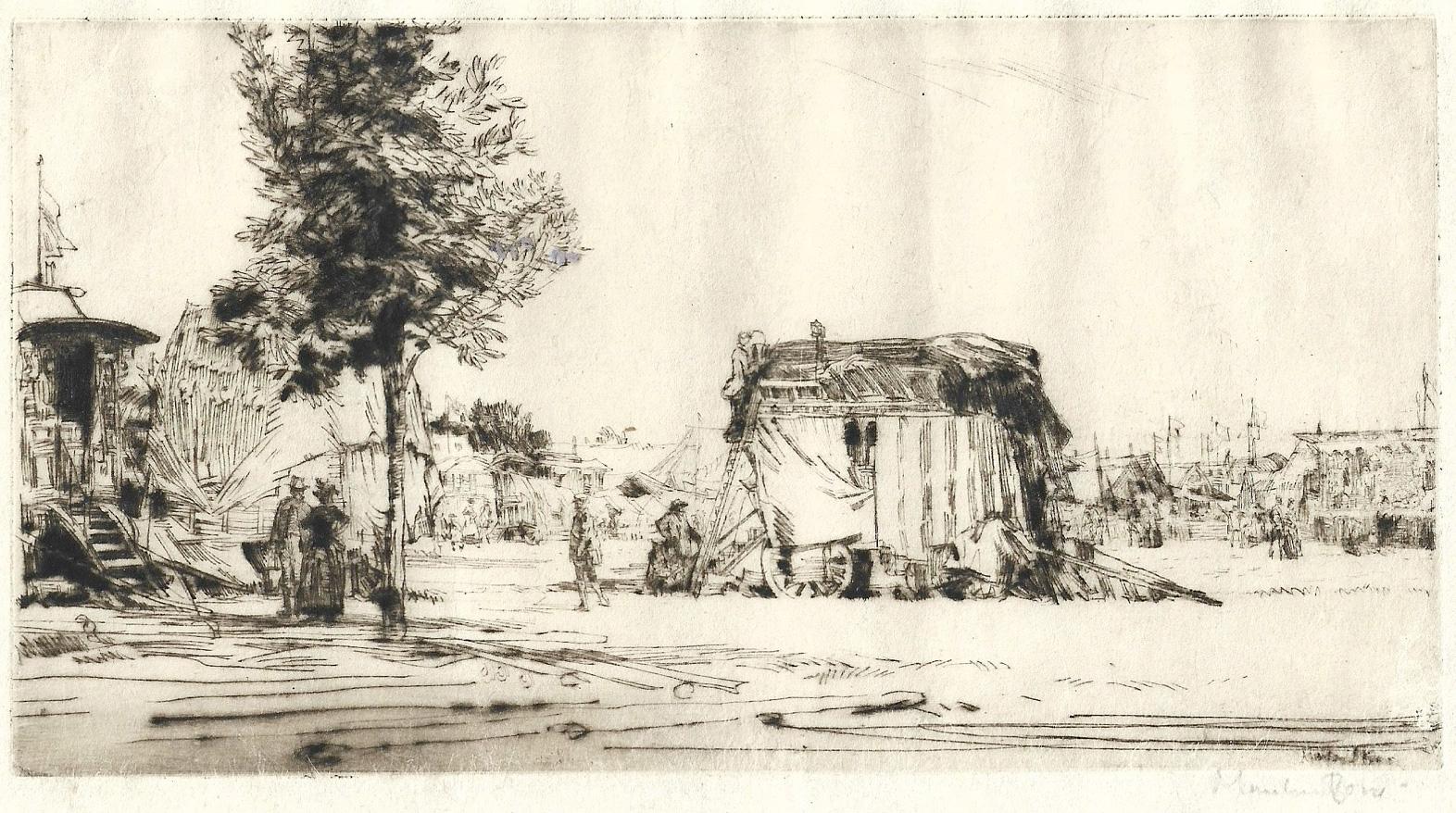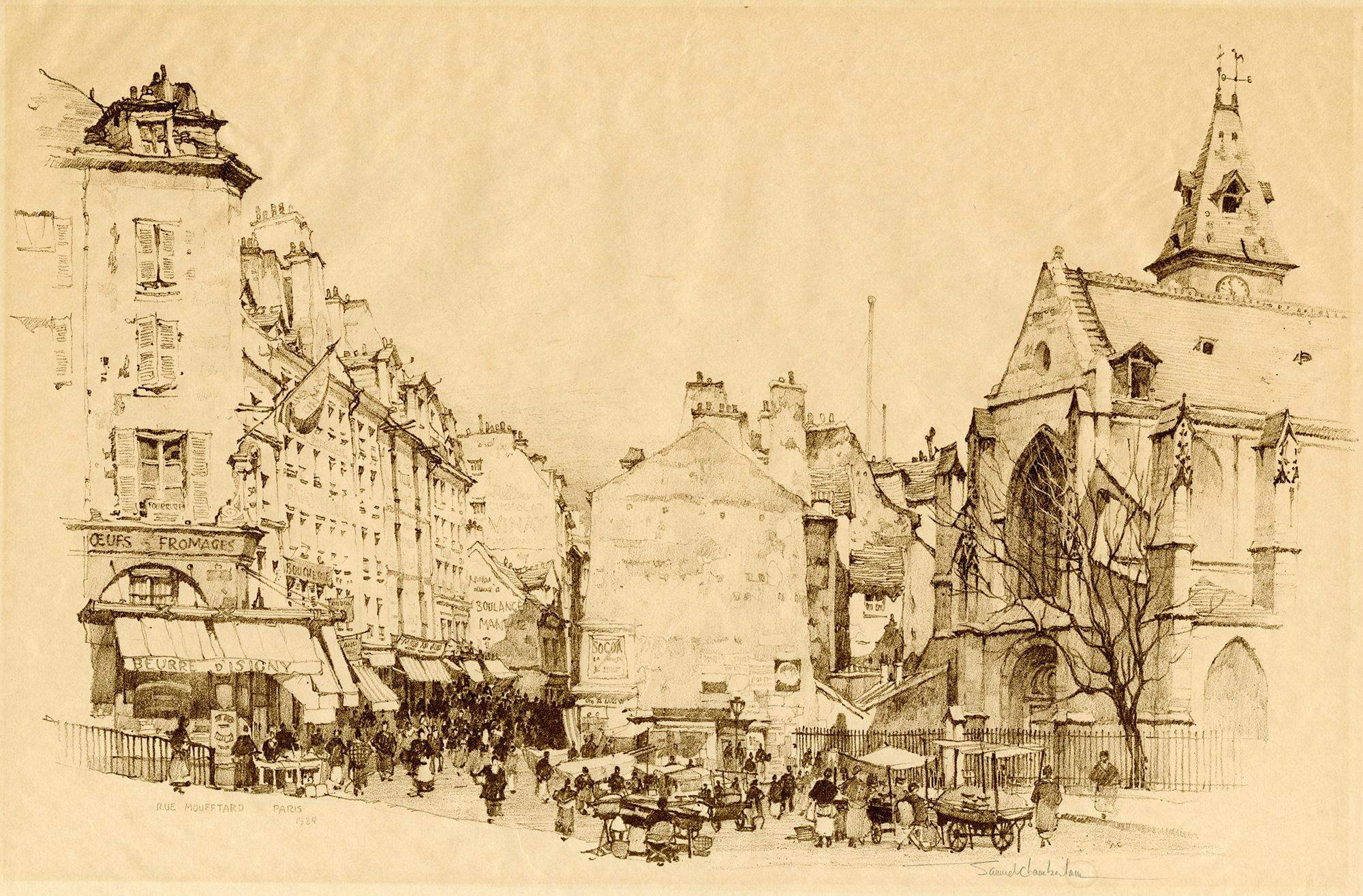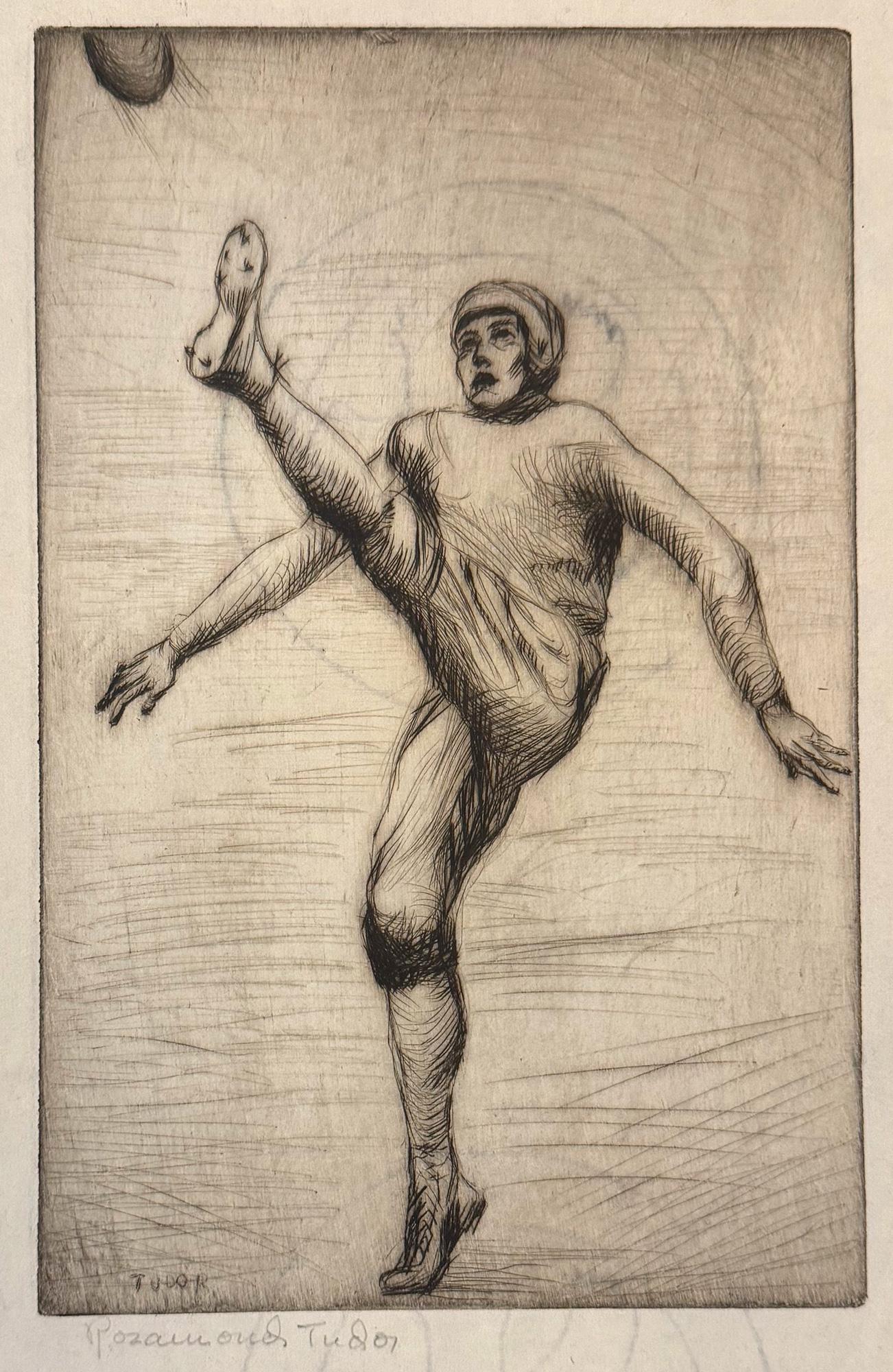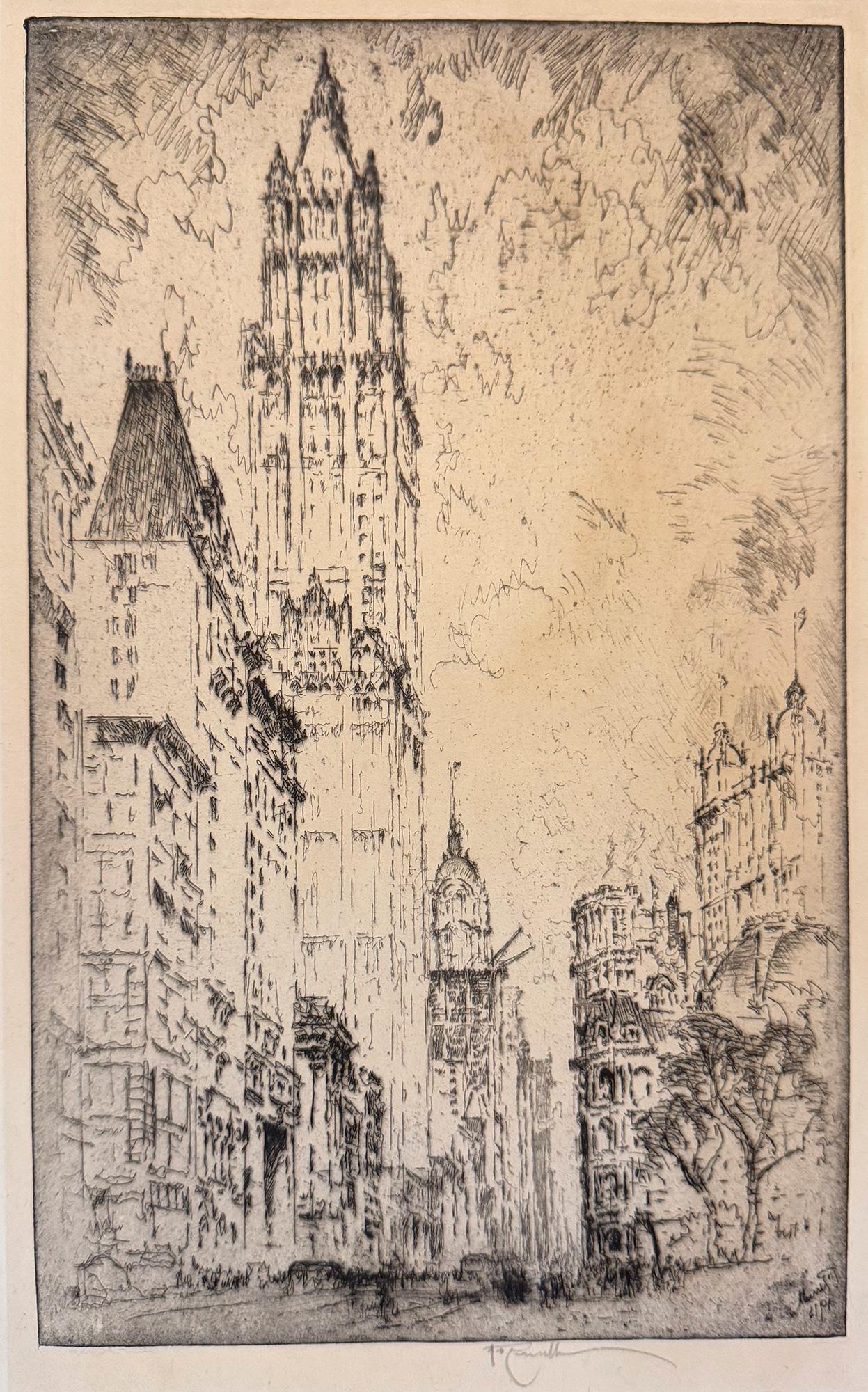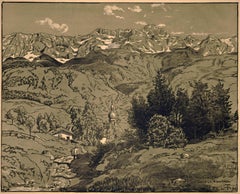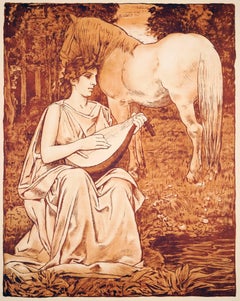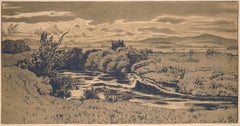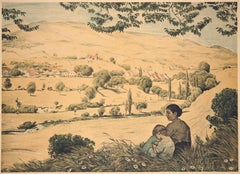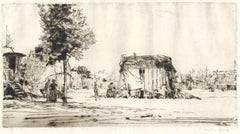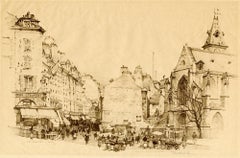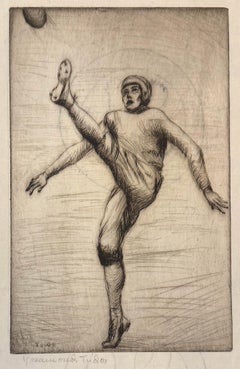Articoli simili a Wilhelm Leibl (1844-1900), Original Etchings, Kunstverlag Gurlitt, 1900
Vuoi altre immagini o video?
Richiedi altre immagini o video al venditore
1 di 24
Wilhelm LeiblWilhelm Leibl (1844-1900), Original Etchings, Kunstverlag Gurlitt, 19001900
1900
Informazioni sull’articolo
Wilhelm Leibl (1844 Cologne - 1900 Würzburg), Linen portfolio by Kunstverlag Gurlitt with 11 (of 11) original etchings, 1900, copy no. 67 / 100, 49.8 cm x 32 cm (portfolio size), 43.5 cm x 30 cm (sheet sizes), the etchings printed on old Dutch laid paper each under passepartout, print of the graphics by O. Felsing in Berlin, two sheets title and index. The portfolio contains the etchings Gronau 2, 3, 5, 10 and 13-19: Maler Wopfner /Maler Sperl / Bäuerin / Junge mit Krug / Leibl's Tante / Alte Frau mit Stock / Leibl's Haus / Landschaft / Ochsengespann / Mädchenkopf / Landschaft mit hohen Bäumen
- Portfolio stained in the upper area and somewhat foxed overall, etchings in very good condition
- Atmospheric conciseness -
Published in the year of Wilhelm Leibl's death, this portfolio comprises eleven sheets removed from the original plates. It represents a significant portion of his body of work, consisting of nineteen etchings. Thus, it pays homage to the etcher Leibl.
Inspired by Rembrandt, the images feature strong contrasts of light and dark, lending them a mysterious quality and robust character. These qualities form the basis for Leibl's masterful precision in capturing the motifs.
About the artist
Wilhelm Leibl first studied art with Franz Everhard Bourel and Hermann Heinrich Becker in Cologne. From 1863 to 1869, he attended the Munich Art Academy, where he became a master student of Karl von Piloty. While still a student, he created his work Frau Gedon, which was exhibited in Munich's Glaspalast in 1869 and earned him international admiration. After becoming aware of Leibl, Gustave Courbet invited him to Paris, where he socialized with German artists Hans Thoma, Louis Eysen, and Otto Scholderer, and discovered the art of Édouard Manet. While in Paris, Leibl won the Salon's gold medal for "Frau Gedon," a painting that had already been praised in Munich the previous year. The outbreak of war forced Leibl to return to Munich, where a circle of artists formed around him, including Wilhelm Trübner, Carl Schuch, Theodor Alt, Karl Haider, and Hans Thoma for a time. Leibl retired to the countryside outside Munich in 1873. It was during this time that he became involved in printmaking.Between 1873 and 1877, he produced a total of twelve etchings. In 1878, Leibl moved to Chiemgau and first settled in Berbling. Then, in 1881, he moved to Aibling. In 1893, he moved to Kutterling with the artist Johann Sperl. Following the first public purchases of his work, he was awarded the title of professor in 1891 and became an honorary member of the Berlin Academy in 1893. However, Leibl did not work as a university lecturer. In 1898, he traveled to Holland with the art dealer Ernst Seeger, where he studied the works of Frans Hals and Rembrandt in detail. These artists were important to him.
Due to his choice of motifs and their precise design, Wilhelm Leibl is considered the most important representative of German realism.
GERMAN VERSION
Wilhelm Leibl (1844 Köln - 1900 Würzburg), Leinenmappe des Kunstverlags Gurlitt mit 11 (von 11) Original-Radierungen, 1900. Exemplar Nr. 67 / 100, 49,8 cm x 32 cm (Mappengröße), 43,5 cm x 30 cm (Blattgrößen), die auf altholländischen Bütten gedruckten Radierungen jeweils unter Passepartout, Druck der Graphiken bei O. Felsing in Berlin, zwei Blatt Titel und Inhaltsverzeichnis. Die Mappe enthält die Radierungen Gronau 2, 3, 5, 10 und 13-19: Maler Wopfner /Maler Sperl / Bäuerin / Junge mit Krug / Leibl's Tante / Alte Frau mit Stock / Leibl's Haus / Landschaft / Ochsengespann / Mädchenkopf / Landschaft mit hohen Bäumen
- Mappe im oberen Bereich fleckig und insgesamt etwas stockfleckig, Radierungen in sehr gutem Zustand
- Atmosphärische Prägnanz -
Die in Wilhelm Leibls Todesjahr erschienene Mappe umfasst mit 11 von den Originalplatten abgezogenen Blätter einen großen Teil seines insgesamt 19 Radierungen zählenden druckgraphischen Oeuvres und ist damit eine Hommage an den Radierer Leibl.
In einer an Rembrandt geschulten Weise entfalten die Bilder starke Hell-Dunkel-Kontraste, die ihnen etwas geheimnisvoll Diffuses, zugleich aber auch einen harten Charakter verleihen, der die Grundlage für Leibls meisterhafte Präzision darstellt, mit der er die Motive konkretisiert.
zum Künstler
Nach einem ersten Zeichenuntereicht bei Franz Everhard Bourel und Hermann Heinrich Becker in Köln studierte Wilhelm Leibl von 1863 bis 1869 an der Münchner Kunstakademie und wurde dort Meisterschüler von Karl von Piloty. Sein noch als Student geschaffenen Werk ‚Frau Gedon’, das 1869 im Münchener Glaspalast ausgestellt wurde, brachte ihm internationale Bewunderung ein. Gustave Courbet wurde auf Leibl aufmerksam und lud ihn nach Paris ein, wo er neben Courbet mit den deutschen Künstlern Hans Thoma, Louis Eysen und Otto Scholderer verkehrte und die Kunst Édouard Manets entdeckte. In Paris gewann Leibl die Goldmedaille des Salons für sein bereits im Jahr zuvor in München gerühmtes Gemälde ‚Frau Gedon‘. Durch den Kriegsausbruch war Leibl gezwungen, nach München zurückzukehren, wo sich um seine Person der Leibl-Kreis etablierte, zu dem unter anderen Wilhelm Trübner, Carl Schuch, Theodor Alt, Karl Haider und zeitweilig auch Hans Thoma gehörten. 1873 zog sich Leibl aus München aufs Land zurück. In diese Zeit fällt seine Beschäftigung mit der Druckgrafik. Zwischen 1873 und 1877 fertigt er insgesamt 12 Radierungen an. 1878 zog Leibl in den Chiemgau und ließ sich zunächst in Berbling, 1881 in Aibling und 1893, gemeinsam mit dem Künstler Johann Sperl, in Kutterling nieder. Nach ersten öffentlichen Ankäufen seiner Werke wurde ihm 1891 der Professorentitel verliehen und 1893 erfolgte die Ernennung zum Ehrenmitglied der Berliner Akademie. Leibl wurde allerdings nicht als Hochschullehrer tätig. Gemeinsam mit dem Kunsthändler Ernst Seeger reiste er 1898 nach Holland, wo er nochmals eingehend die Werke der für ihn wichtigen Künstler Frans Hals und Rembrandt studierte.
Mit der Auswahl seiner Motive und ihrer präzisen modellierten Gestaltung gilt Wilhelm Leibl als wichtigster Vertreter der deutschen Ausprägung des Realismus.
Informazioni sul venditore
5,0
Venditore Oro
Venditori Premium con valutazione 4,3+ e tempi di risposta entro 24 ore
Fondazione nel 2014
Venditore 1stDibs dal 2023
18 vendite su 1stDibs
Tempo di risposta standard: 6 ore
- SpedizioneRecupero del preventivo…Spedizione da: Berlin, Germania
- Politica di reso
Alcune parti di questa pagina sono state tradotte automaticamente. 1stDibs non può garantire che le traduzioni siano corrette. L’inglese è la lingua predefinita del sito.
Garanzia di autenticità
Nell’improbabile caso in cui si verifichi un problema con l’autenticità di un articolo, contattaci entro un anno per ottenere un rimborso completo. DettagliGaranzia di rimborso
Se il tuo articolo non corrisponde alla descrizione, è danneggiato durante il trasporto o non arriva, contattaci entro 7 giorni per un rimborso completo. DettagliAnnullamento entro 24 ore
Hai un periodo di tolleranza di 24 ore per annullare il tuo acquisto, senza necessità di fornire spiegazioni.Venditori professionali selezionati
I nostri venditori di livello internazionale devono aderire a rigorosi standard di servizio e qualità, garantendo l’integrità delle inserzioni.Garanzia miglior prezzo
Se scopri che un venditore ha pubblicato altrove lo stesso articolo a un prezzo più basso, applicheremo lo stesso prezzo.Consegna globale affidabile
La nostra rete di vettori leader del settore offre opzioni di spedizione specializzate in tutto il mondo, inclusa la consegna personalizzata.Altro da questo venditore
Mostra tuttoS. Anton Patenkirchen / - La casa del paesaggio
Hans Thoma (1839 Bernau - 1924 Karlsruhe), S. Anton Patenkirchen, 1895. Algrafo su carta a trama forte, pubblicato da Breitkopf und Härtel a Lipsia come "Zeitgenössisches Kunstblatt ...
Categoria
Anni 1890, Realismo, Stampe figurative
Materiali
Carta
Muse / - Nel regno delle muse
Hans Thoma (1839 Bernau - 1924 Karlsruhe), Muse, 1893. Algrafo su carta a trama forte, pubblicato da Breitkopf und Härtel a Lipsia come "Zeitgenössisches Kunstblatt Nr. 174", 43,5 cm...
Categoria
Anni 1890, Realismo, Stampe figurative
Materiali
Carta
Allo stagno / - L'anelito del paesaggio -
Hans Thoma (1839 Bernau - 1924 Karlsruhe), Allo stagno, 1897. Algrafo su carta a trama forte, pubblicato da Breitkopf und Härtel a Lipsia come "Zeitgenössisches Kunstblatt Nr. 148", ...
Categoria
Anni 1890, Realismo, Stampe figurative
Materiali
Carta
Paesaggio estivo della Germania meridionale / - Il profilo del paesaggio - Il profilo del paesaggio.
Hans Thoma (1839 Bernau - 1924 Karlsruhe), Paesaggio estivo della Germania meridionale, 1897 circa. Algrafo su carta a trama forte, pubblicato da Breitkopf und Härtel a Lipsia come "...
Categoria
Anni 1890, Realismo, Stampe figurative
Materiali
Carta
Il ragazzo alla fonte / - L'elisir di lunga vita
Hans Thoma (1839 Bernau - 1924 Karlsruhe), Ragazzo alla fonte, 1897. Algrafo su carta a trama forte da un disegno del 1897, pubblicato da Breitkopf und Härtel a Lipsia come "Zeitgenö...
Categoria
Anni 1890, Realismo, Stampe figurative
Materiali
Carta
Agonia - L'architettura della decadenza -
Jörg Olberg (*1956 Dresda), Agonia, 1987. acquaforte, E.A. (edizione di 30), 24 x 17 cm (immagine), 46 x 37 cm (foglio), ciascuna firmata a matita in basso a destra "Olberg" e datata...
Categoria
Anni 1980, Realismo, Stampe figurative
Materiali
Acquaforte, Carta
260 USD Prezzo promozionale
20% in meno
Ti potrebbe interessare anche
William Hogarth . Incisioni originali 155 pсs., 1 pezzo con miscela. 1822 Londra
Di William Hogarth
William Hogarth (1697-1764)
Incisioni originali 155 pсs., 1 pezzo con miscela. 1822 Londra
Dalla collezione di A. Neibergs
Categoria
Anni 1820, Realismo, Stampe figurative
Materiali
Carta, Incisione
2.979 USD Prezzo promozionale
20% in meno
Fiera di mezza estate di Cambridge
Di Sir Muirhead Bone
Un'immagine pacifica del primo artista di guerra ufficiale della Gran Bretagna.
Puntasecca stampata con inchiostro nero brunastro su carta Japon fibrosa, 85 x 161 mm, margini pieni....
Categoria
Inizio XX secolo, Realismo, Stampe (paesaggio)
Materiali
Carta fatta a mano, Puntasecca
Rue Moufftard, Parigi
Di Samuel Chamberlain
Litografia a inchiostro marrone su carta Japon leggera e color crema, con bordo declinato, 10 3/4 x 17 pollici (274 x 432 mm), margini pieni. Firmato e numerato 9/35 a matita nel mar...
Categoria
Inizio XX secolo, Realismo, Stampe (paesaggio)
Materiali
Carta fatta a mano, Litografia
Il Punt
Di Rosamond Tudor
Una dinamica immagine di calcio degli anni '20 di un'artista femminile nota per le sue scene sportive.
Acquaforte con puntasecca su carta Japon eccezionalmente fine con doppia filig...
Categoria
Inizio XX secolo, Realismo, Stampe (paesaggio)
Materiali
Carta fatta a mano, Puntasecca, Acquaforte
500 USD
Edificio Woolworth, New York
Di Paul Schumann
Un'immagine ricca e tonale di un'icona dell'architettura di Manhattan.
Acquaforte con puntasecca, 11 7/8 x 7 3/8 pollici (300 x 186 mm), margini pieni. Edizione di 100 esemplari. Fi...
Categoria
Inizio XX secolo, Realismo, Stampe (paesaggio)
Materiali
Carta fatta a mano, Puntasecca, Acquaforte
Richard Haas, The Rookery Courtyard, Chicago, s/n acquaforte architettura e arte
Di Richard Haas
Richard Haas
Cortile del Rookery, Chicago, 1974
Acquaforte su carta da macero
Firmato, intitolato e numerato 11/50 a matita di grafite sul recto.
Telaio incluso
Acquaforte su carta ...
Categoria
Anni 1970, Realismo, Stampe (paesaggio)
Materiali
Carta di stracci, Acquaforte
